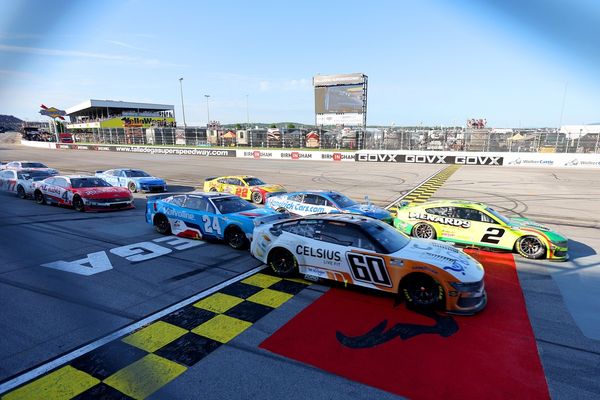On the phone from Los Angeles, Emily Swallow doesn’t sound much like the Armorer, the helmet-wearing character from hit Disney+ “Star Wars” series “The Mandalorian,” who forges equipment and armor from the incredibly strong beskar steel and dispenses bits of Mandalorian wisdom to one to the show’s lead characters, Din Djarin (Pedro Pascal).
Apologies, because we’re sure you get this a lot, but can you please do the voice?
“Well, let’s see,” Swallow says, already sounding more like the mysterious figure. “When one chooses to walk the way of the Mandalore, you are both hunter and prey.”
Oh, yeah, that’s the stuff. (We also would have accepted simply, “This is the way.”)
Created by Jon Favreau with the help of George Lucas protege Dave Filoni, “The Mandalorian” is in the middle of its third season. Swallow chatting with us on the day of the release of the season's fourth episode, in which the Armorer is a key player. (That’s her in costume on the screen, she says, so it’s not just a voice performance.)
Born in Washington, D.C., but raised largely in Jacksonville, Florida, Swallow also is known for several episodes of the CBS series “The Mentalist” and for portraying Amara/The Darkness — “the big bad,” as she puts it, of the 11th season of the long-running WB/CW series “Supernatural.”
“The writers created this villain who was so relatable,” she says. “You could absolutely understand why she did the things she did.
(The writers “didn’t necessarily justify why she was smiting people and sucking their souls,” she allows.)
“I have kept a family from shooting that show and all the different actors that I worked with — and even the actors I didn’t work with.”
In a conversation edited for space and clarity, she talks about the event, “The Mandalorian” — including the real star of the show — and more:
Q: Were you much of a “Star Wars” fan growing up?
A: Yeah, “Star Wars” was a part of the fabric of my childhood. I didn’t know a world without “Star Wars.”
My earliest “Star Wars” memory is tied to the Ewoks. I played Ewok adventures in my backyard. Ewoks were totally my jam.
And, of course, I was a fan of Princess Leia. And I always tell people these days, “I wanted to do the Princess Leia hair before we had YouTube tutorials.” It was such a hardship compared to these days.
Q: Kids today don’t know how easy they have it.
A: Exactly! (Laughs.) We struggled!
Q: When you got this role, did you have to become steeped in Mandalorian history and learn all about the properties of beskar steel, or was it enough to just know your lines?
A: A little bit of both. I mean, I definitely wanted to learn more about Mandalorian culture when I first got cast. I had not watched “The Clone Wars” or any of the animated series, so I had to catch up on that.
But one of the things that has been so intriguing to me about working on this character is it’s actually really helpful not to know too much about her. I find that she changes a lot, and sometimes she changes scene-to-scene episode-to-episode in terms of knowing what to attach to her. And we’ve talked a lot about what she stands for symbolically and how she can best serve Din’s character in the arc of the story. She’s sort of bigger than a specific person that way. She functions sort of mythically — she’s an archetype.
I am very fortunate to have Dave and Jon there on set — Dave Filoni is, of course, a walking encyclopedia of Mandalorian knowledge, so any questions that I needed to ask … I could just go to him. But, yeah, there have been things that I think I know about her, and I’ll get a new script and think, “OK, I guess that’s not true.” She’s still a little bit of a mystery to even me.
Q: The Armorer has a strong belief in the Mandalorian “way,’ which, in part, requires not taking off one’s helmet around others. We’ve never seen your face in the show, and we’re imagining there’s a chance we never will. There are reports that frustrated Pascal, but, regardless of the accuracy of those reports, how do you feel about it?
A: I love it for the character. I think that it really serves her that we don’t see her face.
On the most basic ego-actor level, of course there’s a part of me that’s like, “Oh man, I wish I could take off my helmet so people know who I am. But in terms of the story, I really love that we don’t attach too much personality to her because I do think that she, as a character, functions so much in service to her people, functions so much in service to Din Djarin to further his story.
As an actress — I’ve been doing this for a (few) years now — I am all too aware of what I look like and how that has played into whether or not I’ve been cast in certain parts, how people perceive whether I’m right for certain things. And I get way too caught up in that. To have this one character that has become beloved among the fans and that little girls look up to and people admire and people respect — and for that to have absolutely nothing to do with what I look like — is really cool. It’s incredibly freeing.
Then as for her as a character, I also think she is respected among her people. She’s a woman, but that’s sort of just a detail that isn’t exceptional at all. She’s respected and admired and feared by some people, and that also has nothing to do with what she looks like.
I like that that exists for her. It keeps her more mysterious. So, I’m sure if they do reveal her face, they’ll have a very good reason for it. But at the moment, I really like what it does for her, that there’s still that extra mystery and that we can’t pin her down.
Q: Yes, and obviously you’ve been in other projects, but it probably makes it easier to go to the grocery store right now than it would be if your face was all over this show.
A: Yeah, definitely. People recognize me a lot for Amara from “Supernatural” or from “The Mentalist” than from “The Mandalorian.”
Q: We’re sure you can’t say much about what’s ahead in this season, but at the very least, you can say that we haven’t seen the last of you?
A: Right. And I love the season for the way that it finally is delving into some of those tensions between the more traditional Mandalorians — the ones that do keep their helmets on — and the ones that have really challenged that.
Q: Well, we think everyone wants to know what Grogu, aka “Baby Yoda,” is like in real life.
A: Oh my gosh, he’s the biggest diva! I mean, he has not agreed to do a single interview. Like, he won’t talk to anybody, and we’re all out here trying to promote the show. (Laughs.)
Q: Is there anything else you can say about the show before we move on about what’s coming? We know you’re limited in that area.
A: Keep watching because it’s just going to get better and better.
Q: We have to ask you about another big show, another starring Pedro Pascal: HBO’s “The Last of Us.” You voiced the character Emily in the video game “The Last of Us Part II.”
A: I did motion-capture work for that, too.
Q: Have you started lobbying showrunners Craig Mazin and Neil Druckmann to play the character in a future season?
A: Well, only through interviews like this because everybody has asked me about it. I am definitely open to the idea if they would have me.
It’s been years now since I did the work for that video game. I was just absolutely captivated by what (Druckmann, Naughty Dog game studio co-president) has been able to do with the storytelling through video games and the fact that he’s now been able to translate that to this television series and to do it so successfully. People are completely caught up in that world and really loving the ride. I would love to be a part of that.
I wouldn’t mind playing another character, who maybe, stays alive a little longer. (Laughs.) Mine dies pretty quickly.
———







